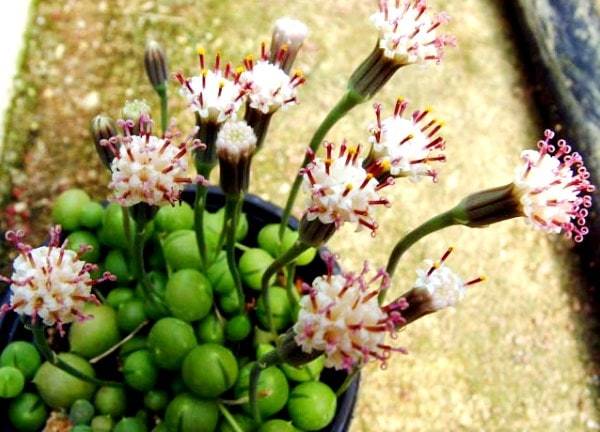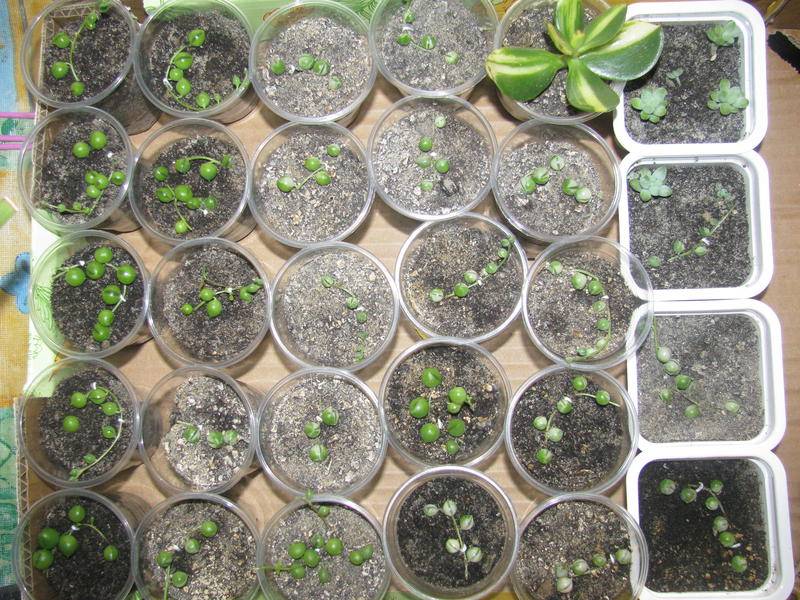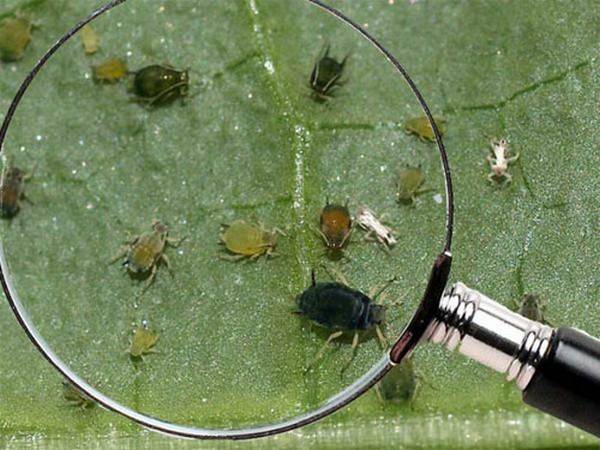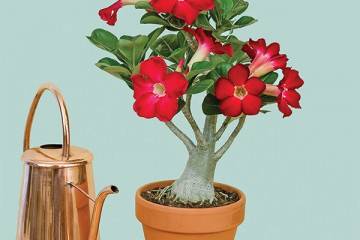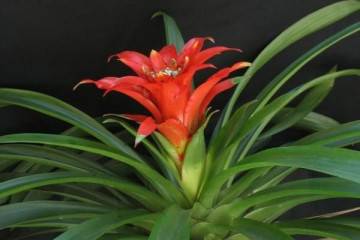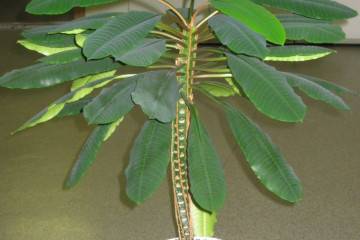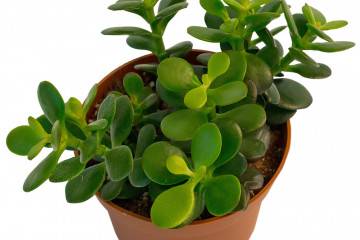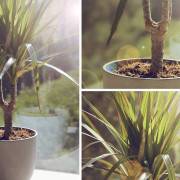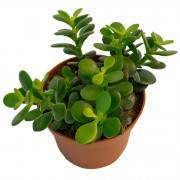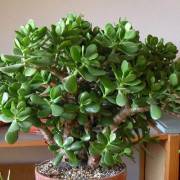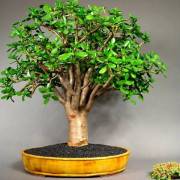Rowley's groundwort Senecio rowleyanus - what a flower
Content:
Rowley's groundwort is a succulent plant. Its globular leaves give it an exotic appearance that cannot be confused with anything. The flower is completely undemanding to care for, as it has the ability to accumulate moisture. He can not only decorate the interior of the room, but also become a highlight in the flower bed.
Rowley's Rowley Description
At home, the ampelous groundwort has a size of about 60 cm in length. But if it is grown in open ground, then the flower can reach 2 m. The main feature of the wild rose is its fragile and elongated stems. The dark green, globular leaves are approximately 10 mm in diameter. There are small sharp points at their ends. One gets the impression that strings with strung beads are hanging from the pot.
Breeders have bred a group of plants with high decorativeness - variegated groundwort (Variegata). In this flower, the leaves are arranged and grow irregularly, have orange blotches.
Rowley's groundwort is a perennial plant that represents the Astrov family.
The groundwort also has another name - green pearl. It is native to the drylands of Namibia, which explains its ease of maintenance and resilience to climate change.
Senecio rowleyanus flower care at home
Growing requirements are the same as for all succulents (plants that come from dry areas). How do you raise Rowley's grub and provide it with home care?
Illumination and temperature conditions
In summer, the most suitable temperature for a flower is 20-28 ° C, and in winter - 10-15 ° C. The plant is very light-loving, but, like other flowers, does not tolerate direct sunlight.
Watering rules and humidity
The ground plant can easily do without water. It is in excellent condition even during the winter heating season, when the heaters significantly dry the air in the room. But in the summer it should be watered regularly. In this case, it is imperative to monitor the condition of the root system so that it does not start to rot.
This flower does not need to be sprayed. In case of oversaturation with moisture, the plant will lose its attractiveness: the stem will elongate, the leaves will begin to grow distantly from each other, the foliage will lose its splendor and juiciness.
In winter, the frequency of watering is determined by the air temperature in the room. When you are in a warm room, the number of procedures is reduced (compared to summer). But if Rowley's grub is in a cool room, then watering is required once a month.
Top dressing and soil quality
The most suitable soil for a plant is considered to be soil for succulents and cacti. In addition, perlite or chips (brick) are mixed into it.
If desired, you can prepare the soil yourself. For this purpose, the following ingredients are required (in equal parts):
- sand;
- peat land;
- crumb (brick);
- leaf humus.
Flower container size
Senecio rowleyanus has a small root system, which makes the pot wide, but not deep. A drainage layer of fine gravel or expanded clay is laid at the bottom of the container.
Features of plant transplant
A young plant must be transplanted once a year, and an adult - once every 3-4 years (depending on the rate of growth and development). When transplanting, it is imperative to follow the precautionary rules, since the flower is dangerous to humans. Also, the procedure is carried out very carefully due to the fragility of the roots and leaves.
Step-by-step instructions for transplanting:
- Fill a new container with earth (halfway).
- Remove the plant (along with a small lump of soil) from the old pot.
- Place in a new pot and sprinkle with earth on all sides.
- Water, and next time only after two days.
Flowering and dormant period of the plant
Rowley's groundwort begins to bloom in late spring and ends in early summer. The rest of the year it is dormant.
Type and shape of flowers
The plant has tubular flowers of light pink or white. They are collected in a dense basket like daisies or dandelions. The inflorescence is located on a thick and high peduncle. A light and pleasant aroma emanates from the flowers.
Rowley's ragwort propagation
The plant reproduces in three ways:
- cuttings;
- seeds;
- layering.
Rooting of leaf and stem cuttings
Twigs 5 cm long are selected and placed in a container. To make the future flower lush and attractive, several cuttings are planted in the pot. After 7 days, roots will appear. During this period, it is necessary to ensure that the soil is moist.
Layers
The stem of an adult plant is pressed to the ground in order to root. Berries must be removed at the point of pressing into the soil. After the roots appear, the layers are cut off from the mother bush. In this case, it is very important that the soil is constantly moistened.
Seeds
Only fresh seeds are suitable for reproduction, otherwise they will not sprout. First, they need to germinate, and only then plant several pieces in a container. After the appearance of the first two leaves, the sprouts are dived and transplanted into different pots.
Possible problems in growing succulents
An excellent distinguishing feature of Rowley's groundwort is resistance to many common diseases. Therefore, if any problems arise, first of all, it is worth suspecting a pest attack or improper care.
A flower grower may face the following diseases:
- powdery mildew. A whitish bloom spreads over the entire surface of the rootwort. For treatment, it is necessary to remove the affected areas and treat with fungicides (up to 4 times).If you do not take action in time, then the plant can lose its attractiveness in appearance and even die;
- gray rot. It usually appears when there is excessive soil moisture, poor lighting or low temperatures. First of all, the root is affected, plaque appears on the stems, the leaves become lethargic. In this case, it is required to transplant the flower into a new soil, having previously treated the root system with a fungicide solution. In advanced cases, healthy shoots are rooted. For the prevention of the disease, the correct conditions for keeping the flower are maintained.
Among the most common pests are:
- spider mite. A thin web appears on the inside of the leaves, and their color changes to brown. For rescue, treatment with insecticidal agents is needed;
- greenhouse aphid. The whole flower is affected: the leaves turn yellow, the inflorescences become brown. In this case, the plant is treated with insecticides. As a preventive measure, the room is constantly ventilated and maintained at the required humidity level;
- mealybug. This harmful insect feeds on flower juices, which greatly depletes it. Pests are identified by egg clutches on the leaves. You can get rid of mealybugs by spraying with a solution of alcohol or soap. In severe cases, an emulsion of karbofos is used.
In general, Rowley's groundwort belongs to unpretentious plants, so it is easy and simple to care for it. When grown successfully, this unique plant can decorate your home for years.


